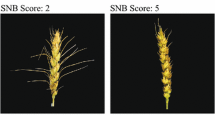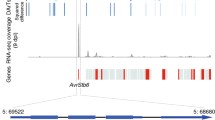Abstract
Stagonospora nodorum, causal agent of Stagonospora nodorum blotch (SNB), is a destructive pathogen of wheat worldwide. As is true for many necrotrophic host–pathogen systems, the wheat-S. nodorum system is complex and resistance to SNB is usually quantitatively inherited. We recently showed that S. nodorum produces at least four proteinaceous host-selective toxins that interact with dominant host sensitivity/susceptibility gene products to induce SNB in seedlings. Here, we evaluated a population of wheat recombinant inbred lines that segregates for Tsn1, Snn2, and Snn3, which confer sensitivity to the toxins SnToxA, SnTox2, and SnTox3, respectively, to determine if compatible host–toxin interactions are associated with adult plant susceptibility to SNB foliar disease under field conditions. Artificial inoculation of the population in 2 years and two locations with a fungal isolate known to produce SnToxA and SnTox2 indicated that compatible SnToxA–Tsn1 and SnTox2–Snn2 interactions accounted for as much as 18 and 15% of the variation in disease severity on the flag leaf, respectively. As previously reported for seedlings, the effects of these two interactions in conferring adult plant susceptibility were largely additive. Additional adult plant resistance QTLs were identified on chromosomes 1B, 4B, and 5A, of which, the 1B and 5A QTLs were previously reported to be associated with seedling resistance to SNB. Therefore, in this population, some of the same QTLs are responsible for seedling and adult plant resistance/susceptibility. This is the first report showing that host-selective toxins confer susceptibility of adult plants to SNB, further substantiating the importance of compatible toxin–host interactions in the wheat-S. nodorum pathosystem.

Similar content being viewed by others
References
Aguilar V, Stamp P, Winzeler M, Winzeler H, Schachermayr G, Keller B, Zanetti S, Messmer MM (2005) Inheritance of field resistance to Stagonospora nodorum leaf and glume blotch and correlations with other morphological traits in hexaploid wheat (Triticum aestivum L.). Theor Appl Genet 111:325–336
Arseniuk E, Czembor PC, Czaplicki A, Song QJ, Cregan PB, Hoffman DL, Ueng PP (2004) QTL controlling partial resistance to Stagonospora nodorum leaf blotch in winter wheat cultivar Alba. Euphytica 137:225–231
Bhathal JS, Loughman R, Speijers J (2003) Yield reduction in wheat in relation to leaf disease from yellow (tan) spot and Septoria nodorum blotch. Eur J Plant Pathol 109:435–443
Czembor PC, Arseniuk E, Czaplicki A, Song QJ, Cregan PB, Ueng PP (2003) QTL mapping of partial resistance in winter wheat to Stagonospora nodorum blotch. Genome 46:546–554
Faris JD, Friesen TL (2005) Identification of quantitative trait loci for race-nonspecific resistance to tan spot in wheat. Theor Appl Genet 111:386–392
Frecha JH (1973) Herencia de la resistencia a Septoria nodorum en trigo. Boletin genetico Jan 8:31–32
Friesen TL, Stukenbrock EH, Liu ZH, Meinhardt SW, Ling H, Faris JD, Rasmussen JB, Solomon PS, McDonald BA, Oliver RP (2006) Emergence of a new disease as a result of interspecific virulence gene transfer. Nat Genet 38:953–956
Friesen TL, Meinhardt SW, Faris JD (2007) The Stagonospora nodorum-wheat pathosystem involves multiple proteinaceous host-selective toxins and corresponding host sensitivity genes that interact in an inverse gene-for-gene manner. Plant J 51:681–692
Friesen TL, Zhang Z, Solomon PS, Oliver RP, Faris JD (2008a) Characterization of the interaction of a novel Stagonospora nodorum host-selective toxin with a wheat susceptibility gene. Plant Phys 146:682–693
Friesen TL, Faris JD, Solomon PS, Oliver RP (2008b) Host-specific toxins: effectors of necrotrophic pathogenicity. Cell Micro 10:1421–1428
Liu ZH, Faris JD, Meinhardt SW, Ali S, Rasmussen JB, Friesen TL (2004a) Genetic and physical mapping of a gene conditioning sensitivity in wheat to a partially purified host-selective toxin produced by Stagonospora nodorum. Phytopathology 94:1056–1060
Liu ZH, Friesen TL, Rasmussen JB, Ali S, Meinhardt SW, Faris JD (2004b) Quantitative trait loci analysis and mapping of seedling resistance to Stagonospora nodorum leaf blotch in wheat. Phytopathology 94:1061–1067
Liu ZH, Anderson JA, Hu J, Friesen TL, Rasmussen JB, Faris JD (2005) A wheat intervarietal genetic linkage map based on microsatellite and target region amplified polymorphism markers and its utility for detecting quantitative trait loci. Theor Appl Genet 111:792–794
Liu ZH, Friesen TL, Ling H, Meinhardt S, Oliver RP, Rasmussen JB, Faris JD (2006) The Tsn1-ToxA interaction in the wheat-Stagonospora nodorum pathosystem parallels that of the wheat-tan spot system. Genome 49:1265–1273
Manly KK Jr, Cudmore HH, Meer JM (2001) Map Manager QTX, cross platform software for genetic mapping. Mam Gen 12:930–932
Nelson JC (1997) QGENE: software for marker-based genomic analysis and breeding. Mol Breed 3:239–245
SAS Institute Inc (2006) SAS/STAT user’s guide, Version 9.1, Cary, NC
Schnurbusch T, Paillard S, Fossati D, Messmer M, Schachermayr G, Winzeler M, Keller B (2003) Detection of QTLs for Stagonospora glume blotch resistance in Swiss winter wheat. Theor App Genet 107:1226–1234
Solomon PS, Lowe RGT, Tan K-C, Waters ODC, Oliver RP (2006a) Stagonospora nodorum: cause of Stagonospora nodorum blotch of wheat. Mol Plant Pathol 7:147–156
Solomon PS, Wilson TJG, Rybak K, Parker K, Lowe RGT, Oliver RP (2006b) Structural characterisation of the interaction between Triticum aestivum and the dothideomycete pathogen Stagonospora nodorum. Eur J Plant Pathol 114:275–282
Stukenbrock EH, McDonald BA (2007) Geographic variation and positive diversifying selection in the host specific toxin SnToxA. Mol Plant Pathol 8:321–332
Toubia-Rahme H, Buerstmayr H (2003) Molecular mapping of QTLs for Stagonospora nodorum blotch resistance in the spring wheat line CM-82036. In: Kema GHJ, Ginkel MV, Harrabi M (eds) 6th International symposium on Septoria and Stagonospora diseases of cereals. Tunis, Tunisia, pp 143–145
Xu SS, Friesen TL, Cai X (2004) Sources and genetic control of resistance to Stagonospora nodorum blotch in wheat. Recent Res Develop Gen Breed 1:449–469
Zadoks JC, Chang TT, Konzak CF (1974) A decimal code for the growth stages of cereals. Weed Res 14:415–421
Zhang Z, Friesen TL, Simons KJ, Xu SS, Faris JD (2008) Development, identification, and validation of markers for marker-assisted selection against the Stagonospora nodorum toxin sensitivity genes Tsn1 and Snn2 in wheat. Mol Breed 23:35–49
Author information
Authors and Affiliations
Corresponding author
Additional information
Communicated by X. Xia.
Mention of trade names or commercial products in this article is solely for the purpose of providing specific information and does not imply recommendation or endorsement by the US Department of Agriculture.
Rights and permissions
About this article
Cite this article
Friesen, T.L., Chu, CG., Liu, Z.H. et al. Host-selective toxins produced by Stagonospora nodorum confer disease susceptibility in adult wheat plants under field conditions. Theor Appl Genet 118, 1489–1497 (2009). https://doi.org/10.1007/s00122-009-0997-2
Received:
Accepted:
Published:
Issue Date:
DOI: https://doi.org/10.1007/s00122-009-0997-2




